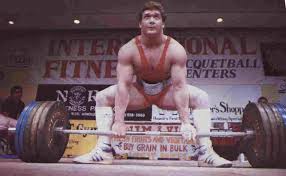Here’s a common dilemma. Someone decides that it’s finally time to get a lagging lift moving. Maybe they have a good squat and deadlift, but the bench press of a prepubescent child. Maybe they’re built like a T-rex and can squat and bench just fine, but their deadlift is lagging. In such situations, people often seek out specialization programs for a single lift. Some popular ones are the Coan/Phillipi deadlift routine, the Russian squat routine, or the Smolov Jr. bench routine.

Some people decry specialization program out of hand, claiming that they’ll necessarily result in overtraining. I don’t think that’s necessarily the case. Certainly you need to keep an eye toward good technique when undertaking a program like that, and you need a solid strength and conditioning base to weather such an increase in training volume in a particular pattern, but for some people such programs are totally appropriate. And, regardless, people use them all the time, whether it’s ill-advised or not, so they may as well make them as effective as possible.
The issue people have is figuring out what to do with the rest of their training when they’re really hammering one lift. The usual advice is “reduce volume/frequency/weight for everything else to allow you to recover.” While that’s not BAD advice necessarily, it can certainly be improved upon.
Where’s the stress?
The first question you need to ask yourself is “what patterns and muscles are being exposed to increased stress on this program?” Specifically, I’m talking about what the limiting factor in the movement is for you. What fails first when you miss a lift, and what’s really sore the day after you do a certain exercise? Those are muscles you’ll want to give a break in the rest of your program.
If you’re squatting and you have solid form, odds are your quads are the limiting factor. Necessary modifications to the rest of your program: don’t do added quad work. Easy peasy.
If you’re more of a good morning squatter and your quads aren’t contributing to the lift to the degree they should (for starters I’d advise you fix the imbalance before you do a high volume squat program, but I know some people won’t listen), your hamstrings and spinal erectors will accumulate fatigue, so you’ll want to avoid extra workload for them.
For sumo pullers, it’ll almost definitely be hips – glute max and medius. Maybe hamstrings as well.
For conventional pullers, it’ll probably be spinal erectors, upper back (traps and/or lats), or hamstrings.
For bench, it’ll probably be either pecs or tris primarily. Be gentle with your shoulders either way. Low bar squats may not be the best idea if you have external rotation issues, but high bar squats, safety bar squats, and deadlifts are all fair game.
What’s being neglected?
If you’re concerned about preserving your other lifts (or even improving them) while on a specialization program, you have to ask yourself what’s being neglected by your specialized lift.
For an example, if you’re an upright, high bar squatter worried about maintaining or improving your deadlift, this will probably be your hamstrings, primarily. Since you’ll want your back fresh for squats, regular deadlifts may be out of the question (or with reduced volume and intensity, at the very least), but RDLs, GHRs, and even hamstring curls are all great options. With strengthened quads, hips, and back from squats, the added hamstring work should be all it takes to keep your deadlift moving. Furthermore, it won’t detract from your squat training.
If you’re running a deadlift specialization program, your posterior chain will get plenty of work, but your quads will be largely neglected, and your hips won’t be going through a full ROM as with squats. Therefore, any quad work is great, especially something like rear leg elevated split squats. To give your grip a break but to ensure you stay upright to take some stress off your back, holding weight in the goblet or front squat position is perfect.
With bench, I’d be leery of adding in any extra pressing while your shoulders adjust, but your upper body pulling musculature is fair game. Rows are perfect here, as are rear delt flyes to balance out the work being done by the anterior deltoid on bench.
Is there any interference?
After you answer the first two questions, you may still run into problems. Rows are probably fine on a bench specialization program, but too much lat fatigue could affect performance. RDLs are probably fine for an upright squatter on a squat specialization program, but if low back fatigue starts accumulating, continuing to train RDLs can exacerbate the problem.
If you are dialing back work on the muscles or patterns that are limiting you, and continuing to train the muscles and patterns not primarily challenged by the lift you’re focusing on, you set yourself up for the greatest odds of improving the lift you’re specializing while maintaining or improving your other lifts. However, be ready to make changes if your performance starts to suffer or pain starts developing. What should work on paper isn’t always what does work in the gym, especially when undertaking a program that’s fundamentally different from anything you’ve exposed your body to. The plan you have for your other lifts should be influenced by these principles, but it MUST be fluid. You already have your specialization program set in stone – let everything else fall in place around it.
Wrapping it all up:
This may not have answered the specific question you may have (with three lifts and many different styles of executions for each one, giving a road map for each would make for a LOOOONG article), but these three simple principles should put you on the right path should you decide to give a specialization program a shot.




